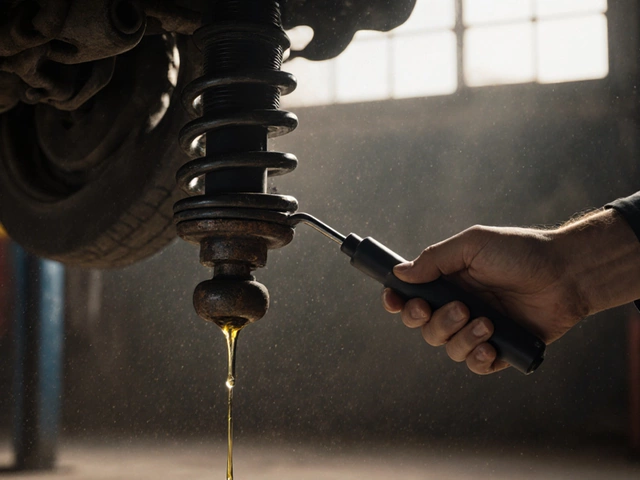The world of car modifications is a thrilling realm where enthusiasts push their vehicles to new limits. Among these modifications, aftermarket exhaust systems are often pursued for their promise of enhanced performance and a deeper, more aggressive sound. But what often gets brushed under the carpet are the potential downsides—issues that might shake your decision to swap out that factory-fitted system.
Diving into this topic, we'll look at what some drivers might stumble upon after the install. These include legal hurdles that can pop up unexpectedly, especially if those shiny new pipes don't meet local regulations. The rumbling soundtrack you crave might just end up as a noise nuisance to those around you, too.
Moreover, it's not just about what’s happening on the outside. Internally, the changes could affect the engine dynamics. And when it’s time to part with your beloved vehicle, you might discover the aftermarket mods have made buyers a little wary.
These are just some of the considerations we'll investigate, giving you a clearer view of where the path of aftermarket exhaust systems might lead.
- Legal and Regulatory Concerns
- Increased Noise Levels
- Impact on Engine and Performance
- Effect on Resale Value
Legal and Regulatory Concerns
When it comes to installing an aftermarket exhaust system, navigating the labyrinth of laws and regulations is one of the most crucial yet often overlooked aspects. In many regions, particularly across Europe and North America, strict emission standards and noise regulations dictate what can and cannot be installed on a vehicle. These rules are not just bureaucratic hurdles; they are set in place to reduce pollution and noise, aiming to create a more livable environment for everyone.
Often, aftermarket exhaust systems, designed to maximize performance and sound, may not conform to these stringent regulations. In the UK, for example, the law mandates a limit on the noise a car can produce. If your vehicle exceeds this limit, you could face hefty fines or even have your vehicle taken off the road until the issue is rectified. The Department for Transport in the UK has clear guidelines regarding what levels are permissible. Ignorance of these rules isn't bliss; it's costly.
Moreover, aftermarket exhaust systems can affect emissions compliance. Cars are originally equipped to meet specific emissions standards, and changing the exhaust system might interfere with the catalytic converter's functionality – a crucial component in reducing harmful emissions. Failing to comply not only results in penalties but could also lead to a failed MOT test, keeping your car from being legally driven on public roads.
Real World Implications
Take into account that in the United States, California has some of the strictest emissions and noise laws, with the California Air Resources Board (CARB) ensuring that modifications do not harm environmental efforts. Vehicles must pass both visual and emissions tests to be roadworthy. Non-compliance can see avid car modifiers facing fines up to several thousand dollars. According to a CARB statement, "Aftermarket parts must demonstrate that emissions are not negatively impacted." This highlights the importance of choosing parts that are either certified compliant or specifically designed to work within legal frameworks.
What you choose to install can lead to different consequences depending on where you live. It's crucial to stay informed about the local laws that apply to vehicle modifications, and there are handy resources available for this. Manufacturers often provide certification or documentation for compliance with these regulations, and it's wise to opt for parts with such backing.
Remember, the onus often falls on the vehicle owner to ensure that their car is compliant. Mere possession of an offending exhaust system is not an offence, but the use on public roads often is. Sometimes the shimmering allure of a deeper growl from your car leads enthusiasts into murky waters where legal ramifications outweigh the perceived benefits of enhanced performance. Awareness and research are the keys to staying out of trouble, and making sure you enjoy your modified vehicle within the boundaries of the law.

Increased Noise Levels
When you think about aftermarket exhaust systems, one of the first things that springs to mind is undoubtedly the difference in sound. Many drivers opt for these enhancements to achieve a deeper, throatier roar from their vehicle. It's a way to announce your presence, to feel the thunder beneath your feet as you drive. However, this added noise isn't always music to everyone's ears. Increasing the volume on your car's output can, and often does, cross the line from exhilarating to irritating.
This issue isn't merely about personal preference. There are specific decibel limits in place in many regions to keep noise from becoming a public nuisance. Exceeding these limits can lead to fines or your car failing to pass a vehicle noise inspection. Imagine the frustration of installing a state-of-the-art system only to find it's illegal. According to a study conducted by the UK Department for Transport, vehicles that exceed a sound threshold of 74 decibels are liable for hefty fines. Adjustments have to be made, or tickets accruing can result in more cost than the exhaust itself.
The social impact here is undeniable. If you're living in a densely populated area or frequently driving through quiet neighborhoods, excessively loud vehicles can quickly turn neighbors into adversaries. There’s anecdotal evidence suggesting that overly loud exhaust systems have even contributed to broader community complaints, sometimes leading to stricter legislation. A notable report from the British Council revealed that noise pollution tops the list of urban nuisances, leading to higher stress levels among city dwellers.
Yet, the appeal of a car modification like this isn't only about the noise itself—it's the image it projects. For enthusiasts, a louder exhaust can mean a more powerful, thrilling ride. There's a thrill in knowing each growl is a testament to the power beneath the hood. However, there's a thin line between gutsy and grating. Sometimes, other enthusiasts even argue that the performance gains from these noise-heavy systems are minimal, if present at all.
"A well-tuned exhaust system is an art form, but there's a fine line between getting it right and becoming a load of noise for the sake of it," says automotive expert and Top Gear presenter, Chris Harris.
The aftermarket exhaust debate often circles back to preferences, and therein lies our tip: before you make the switch, experience it firsthand. Find someone who's already made the leap and take their car for a spin. What sounds great on the track might be overbearing on the daily commute. Ensure it’s the symphony you’re after, not a persistently loud reminder on every ride. In the end, while the lure of a roar down the open road is undeniable, keeping sound practical and prospective issues clear in your mind will help you avoid potential pitfalls.

Impact on Engine and Performance
The allure of installing an aftermarket exhaust system often revolves around the potential to unleash more power. Adjusting the flow of exhaust gases can theoretically lead to gains in horsepower and torque. However, the reality might differ for those not cautious enough about the specifics of their setup. While some systems are engineered to improve performance, mismatches in design could cause back pressure issues. This is more than a minor inconvenience; it's a roadblock in the flow of exhaust gases that can negatively affect engine efficiency.
Not every engine is built the same, and a one-size-fits-all aftermarket solution might not just fit wrongly but could assault your engine with unintended power losses. It's crucial to consider how the design of an exhaust system interacts with the vehicle's engine configuration. Individual cylinder scavenging, a critical aspect of exhaust dynamics, can either be enhanced or hindered by aftermarket modifications, impacting the achieved performance enhancements.
There's more to it than just pipe diameter and flow. The materials and build quality of these systems are pivotal. While stainless steel variants offer durability and minimal impact on performance over time, lower-quality metals could rust, leading to unintended air leaks and ultimately power reduction. And while aftermarket systems can be lighter, easing the weight your engine pushes, there's no certainty they will harmoniously align with your engine's factory tune.
Maintaining an optimal balance is key. Vehicle manufacturers spend considerable time tuning stock exhausts to match the car's natural performance curve. An example statement from an automotive journal noted, "While aftermarket systems provide an opportunity for power gains, they often require additional tuning support or engine map adjustments to reap the benefits safely." A recalibration, often through expert tuning, becomes necessary to avoid potential pitfalls.
Interestingly, a small change in performance dynamics can also alter fuel efficiency. The belief that you can simply bolt-on power is misleading. With altered back pressures, your engine might burn more fuel to achieve similar outputs, shaving points off your miles per gallon stats. It’s a trade-off that can make 'more power' not feel like such a boon after all.
Consider the niché but emerging options for exhaust valves, which allow dynamic adjustments. These adjust the exhaust's path, providing a middle-ground for drivers who want control over performance traits without committing to a single static modification. The advancements in technology have allowed manufacturers to create exhaust systems with smart capabilities, giving a tantalizing glimpse into a future where performance feature toggles become standard.

Effect on Resale Value
Navigating the world of car resale can be a tricky endeavor, particularly if you've indulged in some aftermarket modifications, like that much-coveted aftermarket exhaust system. While these modifications might have won the battle for your heart, winning over potential buyers might tell a different story. Cars are deeply personal, but when it comes to resale, what appeals to you might not be everyone's cup of tea. A car enthusiast might see character and power in a throaty exhaust growl, but it's not guaranteed that all buyers will share that sentiment.
It's important to recognize that modifications could deter potential buyers. Some might view extensive modifications as a sign of aggressive driving or a harder life for the vehicle. This could sow doubt about the overall condition and longevity of the vehicle. When browsing second-hand listings, buyers often seek reliability over performance enhancements. A car with fewer modifications might appear as a safer bet to the average buyer. An interesting compare might be made with vintage car restoration. A restored vehicle with modern modifications might not fetch as much as a purely authentic restoration, which holds its own nostalgic value.
In some cases, buyers are uncertain of modifications' effects on the vehicle's overall health. There may be a concern about engine adjustments to accommodate the exhaust system, and this leads to questions about how it was done and by whom. Inevitably, you might face a decreased pool of interested buyers, and this can often translate into a longer period to sell. And when options are more scarce, the asking price tends to drift lower.
Economic Impact
From a pricing perspective, well decided figures can be insightful. Some stats even suggest that modified cars, including those with custom exhausts, could knock off up to 20% off the potential resale value. Of course, prices vary greatly depending on the extent of the modifications and the particular market segment you're targeting.
"Modified vehicles can signal a red flag for inconspicuous buyers. With aesthetics often in mind, practicality may lag behind," says Alexander Smith, a renowned automotive economist.
You might find that stripping the aftermarket exhaust and refitting the original may yield a better resale outcome, cost and effort permitting. On the other hand, if you stumble upon a niche buyer, they might appreciate the work already put into the vehicle, seeing it as saving the trouble of modification themselves. In this way, knowing your audience, both for purchase and sale, can affect how much these changes impact your bottom line.
This road is filled with twists and turns, advice comes in all directions. Yet, understanding these potential outcomes can better prepare you for when the time comes to let go of your machine and ensure it garners the most value from its memories and modifications alike.






